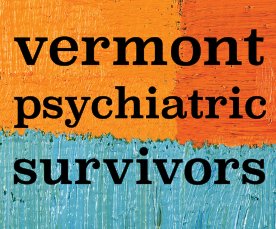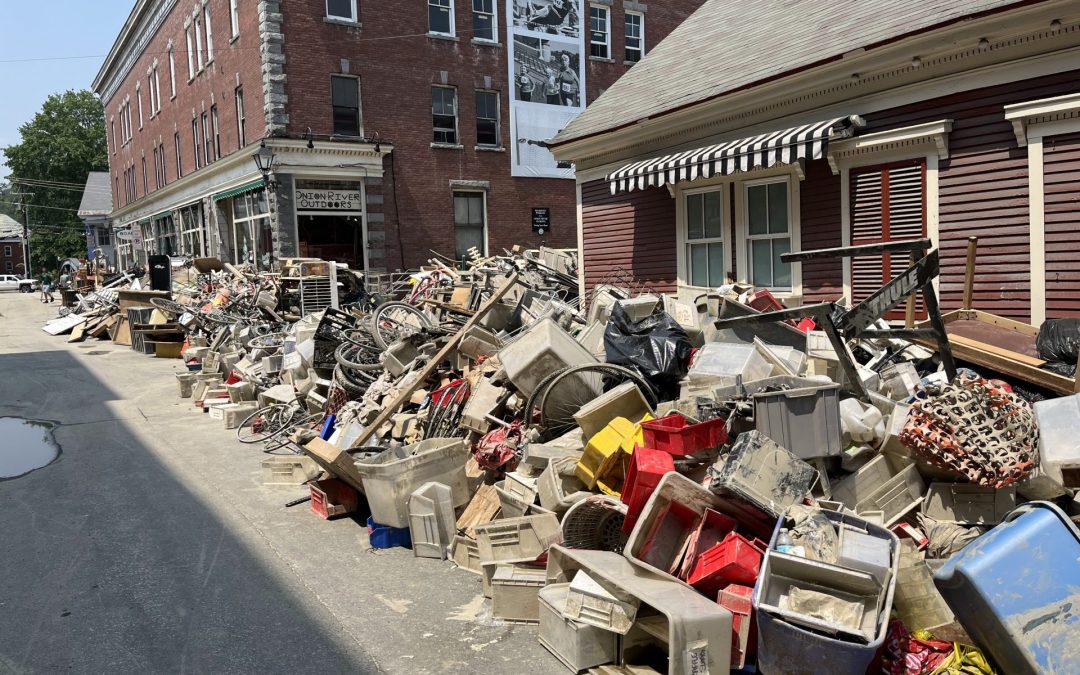By Vermont Emergency Management’s preliminary count, July’s flooding damaged 4,087 homes and 839 businesses statewide. Emotionally and psychologically, the event and its aftermath will yield serious, long-lasting challenges for Vermonters, according to mental health providers.
“It’s awful, and it’s a tragedy, and people need to seek out as much support as they can get in order to maneuver through this,” said Christopher Sloane, a mental health trauma counselor in Montpelier. “Literally, our emotional systems, our nervous systems, they’re flooded right now as well.”
Catherine Baird, who operates Inner Care Counseling and Wellness in downtown Barre, described natural disasters as “overwhelming” events that can strip away people’s feeling of agency.
“The weather is just this thing that’s happening to you, out of your control, sometimes unexpectedly, in many cases not knowing exactly how bad the damage could be,” Baird said. “That’s very terrifying, and when something’s just kind of taken from you – your home, your possessions, your job – that really threatens your sense of livelihood and your sense of being connected and grounded in this world.”
Similarly, Timothy Ricciardello, a clinical social worker who practices in Morrisville, spoke of the storm’s “traumatic effect” upon Vermonters for whom the “threat of physical harm” quickly gave way to “a threat to the sense of self.”
“A lot of people lost everything. Watching old family albums wash away, or grandma’s quilts get ruined from the basement, or whatever it is – it’s very much tied to their identity. Our identity is tied into our security, into our housing, into our livelihood,” Ricciardello said.
This psychological stress can exacerbate the difficulties posed by the practical burdens of recovery, as Tina Ghantous, who provides psychotherapy in Hardwick, pointed out.
“There’s people who are in the stages now of trying to fill out their FEMA form and decide who to talk to and make appointments,” she said. “And all of those basic, kind of administrative, here-and-now, logical functions are really challenging when someone is in a trauma response. So it kind of just sets up for the person not being able to necessarily do what they need to do to get repairs done or get their business up and running again.”
According to Sloane, in upsetting or dangerous situations, the fight-or-flight reaction of the “primitive brain” can disable a person’s capacity for decision-making and reason.
“When you’re in trauma, when you’re having a PTSD response, and then when the frontal lobes go offline, then you’re completely subject to whatever fear or trauma happens to be gripping you,” he said.
Vermonters whose homes stayed dry in July aren’t necessarily immune.
“People were overwhelmed by the impact of three and a half years of COVID, and this on top of it,” Sloane said. “And it can also be overwhelming just to follow the media.”
“You can get addicted to tracking the news, and which town is flooding and how many inches of rain have we had, and what roads are wiped out right now,” he elaborated. “That just keeps our nervous systems on high alert the whole time, and then it gets more and more difficult to function.”
Ghantous cited her own experience as an example of the catastrophe’s inescapability even for those who, in a direct sense, stood relatively unscathed.
“It impacts everyone. I am driving to work, and I’m looking at the devastation of my neighbors. A good part of the way, I’m looking at a farm that lost a whole bunch of their crops,” she described. “My office is on the Lamoille Valley Rail Trail, which is closed down, and this beautiful bridge that I used to walk to on my lunch break is like a matchstick.”
Ghantous, Baird, and Sloane all faced professional roadblocks in the days following the flooding, either because washed-out roads had trapped them or their clients at home or because floodwaters had damaged the buildings housing their offices. But as they had during the pandemic, they managed to keep most of their appointments via Zoom or phone.
Ricciardello’s office in Morrisville was “relatively unaffected,” but Hardwick, the town where he lives, saw more severe flooding. On the night of the rainstorm, he’d signed up as a volunteer at the emergency shelter at the local high school.
“We were kind of just hanging out on the cots, and we didn’t expect it to be that bad,” Ricciardello remembered. “And we kind of joked ‘Who brought the grill and the beers and the hamburgers?’ And then, within two hours, it was like, ‘Oh, this is actually a much more serious event.’”
In Ricciardello’s telling, Hardwick “kind of became an island,” leaving delivery drivers and construction workers to seek refuge overnight. Local residents, rescued from their homes by boat, arrived via police cruiser.
“Of course, they were in a lot of shock. And so it was just making sure they were warm and fed and had dry clothes and had a place to lay their head,” Ricciardello recalled.
As a nearby inn washed away, its guests made their way toward the shelter. The owner, “of course, was devastated,” and volunteers like Ricciardello did what they could to provide emotional support, mostly just by “listening to his story.”
While the initial jolt of the loss of a business or a house may be considerable, Baird warned that victims may become even more vulnerable in subsequent weeks and months.
During the disaster itself, “your brain is going to do everything it can to get you through that stress,” she said. “But it’s when you’re able to actually relax, that’s when a lot of symptoms come up for people.”
Baird emphasized that experiences of trauma don’t always have to lead to the set of long-term symptoms that psychologists call post-traumatic stress disorder.
“I will work with people soon after they’ve experienced an acute trauma to help them process what’s happened and help them learn skills and strategies to help their system navigate this major stressor that they’re now adjusting from to prevent further distress in the system later on,” she said.
Sloane shared a handful of tactics that – although they can’t replace “one-on-one trauma resolution work,” as he put it – can function as “stop-gap measures to help people self-regulate” when they can’t access additional support. They’re designed to keep people in what he called “the here and now.”
“What you do is you walk through your five senses. And you notice what your five senses are telling you about the space that you’re in,” he said. “The only way to do it is to really be in that present moment. And I don’t mean that as a cliche – I mean that as, like, you’ve got to look around. You gotta feel the material of the chair that you’re sitting on. You have to feel your feet on the floor.”
“You’re noticing the quality of the light in the room. You’re noticing the smells of the soup on the stove. You’re noticing the air on your face, whether the room is cool. Or you go outside and you feel your toes in the grass,” he went on. “And you say, ‘Yes, I am safe.’”
A loved one can help.
“Eye contact with a safe, understanding, sympathetic person is one of the keys to self-regulating. And at that point, it becomes co-regulating,” Sloane said.
Ricciardello described psychological trauma as “really complicated on an individual level.” But he observed that July’s flooding hadn’t happened to an individual – it had happened to entire towns.
“It’s affected a community, and so it ends up being kind of this collective trauma, which I think then the approach ends up being slightly different, in the sense of kind of reassuring people that you’re not alone in this, that there are other people there who have experienced similar things who can relate,” Ricciardello said. “There’s a whole community that is stepping up with resources and access to information, access to various forms of support, whether that’s physical or emotional support.”
In Ricciardello’s telling, these free resources ran the gamut in flooded areas of Vermont after the storm, from excavator loans and volunteer driveway repair crews to “community suppers where you can go and just have a free meal and sit with people and share and be supported in that way.”
Ghantous also mentioned volunteer efforts as a source of hope and solace.
“People want to help. And instead of becoming frozen in that fear response and sort of despondent, it’s a way of accessing your own power to do something about it,” she said.
But Ghantous also highlighted the risk of burnout. By late July, she’d already begun to notice signs of emotional fatigue among the scrappy residents of her town, so she and another local therapist began to organize community events that would give them a chance to put down their shovels and engage in conversation and reflection instead.
The first one would take place at the West Glover Congregational Church on July 25. Ghantous hoped it would help boost her community’s long-term resiliency.
“People are pretty tough up here in the Northeast Kingdom,” she said. “If we’re just talking about this place, I don’t think it’s a new idea that, like, oh, this horrible thing happened, and we’re going to get through it.”
Ghantous recognized, however, that some residents might fare better than others in the recovery.
“What I’m seeing is that the people who are the most affected by natural disasters,” she said, “are the people who don’t really have a lot to begin with. There’s some trailers in my area that are completely unlivable at this point – that was a person’s primary residence because they were on, maybe, cheaper land that was in a kind of a swampy area or something like that.”
Just as the toughest financial hardships imposed by the flood would, it seemed, serve to compound preexisting financial disadvantages, its worst psychological impacts would likely afflict those who already harbored deep emotional wounds.
“You know about the studies, I’m sure, where adverse childhood traumas predispose people for more trauma later in life, for addiction, for health problems. And it’s a lot of the people who live in socioeconomic conditions that are already dire, and you put something like climate disaster on top of it, and it’s just this really difficult situation for them that’s not going away anytime soon,” Ghantous said.
Ricciardello speculated that, for some Vermonters, unfortunately, there will be no recovery.
“There’s people who, the reality is, there isn’t coming back from this,” he lamented. “Yes, you can rebuild and fix and these things, but many towns here were completely underwater, and for people who were already kind of towing that line and kind of breaking even, it’s like this has now pushed them over to where it’s, ‘Hey, we can’t actually afford this house, and we have to cut our losses and go,’ or, ‘Hey, this small business that I started a handful of years ago, it’s just not the right time, and it’s not feasible.’”
“And then that shifts more into a grieving process, in my opinion: dealing with the loss – and not in the sense of a loss of life, but just a loss. You know, it’s a loss nonetheless,” Ricciardello continued. “I think there’s going to be plenty of people that are very much going to look at life as before and after the flood of ‘23.”
Meanwhile, luckier Vermonters will still have to worry about the next flood.
“People are not naive to the fact that climate change is happening and has been happening,” Baird said. “We’re going to be experiencing natural disasters again in our lifetime, perhaps many times. And I think people are thinking ahead to, “OK, well, how, how can I get through this, but also how am I going to get through this again?’”

